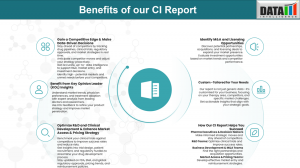New Wave in gMG Care: Cutting‑Edge Biologics Transform Treatment Landscape | Competitive Intelligence
Biologics revolutionize generalized myasthenia gravis care with fast-acting, patient-friendly therapies and a robust global pipeline redefining outcomes.
Generalized Myasthenia Gravis (gMG) is a rare autoimmune neuromuscular disorder in which the body’s immune system produces antibodies that interfere with the communication between nerves and muscles, leading to varying degrees of skeletal muscle weakness. Affecting approximately 12 to 20 people per 100,000 globally, gMG can significantly impair mobility, independence, and quality of life—especially for women under 40 and men over 60.
Historically, treatment strategies centered on corticosteroids, acetylcholinesterase inhibitors, immunosuppressants, and invasive procedures like plasma exchange. However, the recent explosion in biologic innovation has transformed the therapeutic landscape, offering targeted interventions that address the root immune dysfunction of the disease.
Download CI Sample Report: https://www.datamintelligence.com/strategic-insights/ci/generalized-myasthenia-gravis-gmg
Explosive Market Growth Reflects Innovation Surge
The global gMG therapeutics market was valued at $3.78 billion in 2024 and is forecast to expand to $15.57 billion by 2033, registering a CAGR of 17.1%. Growth is propelled by rising prevalence, early diagnosis, improved patient awareness, and—critically—clinical adoption of next-generation biologics.
The New Standard of Care: Approved Biologics Transforming gMG
Complement Inhibitors
- Eculizumab (Soliris) and Ravulizumab (Ultomiris) are C5 inhibitors that block terminal complement activation, reducing immune-mediated damage at the neuromuscular junction.
- Zilucoplan (Zilbrysq), the first subcutaneous C5 inhibitor, approved in 2023–2024, offers patients a home-administered alternative to IV therapy.
FcRn Inhibitors
- Efgartigimod (Vyvgart), approved in 2021, blocks the neonatal Fc receptor, reducing levels of pathogenic IgG antibodies. Available in both IV and subcutaneous formulations, it has quickly become a preferred option.
- Rozanolixizumab (Rystiggo), a subcutaneous FcRn inhibitor approved in 2023, offers broad efficacy with fewer clinical visits.
New Entrant
- Nipocalimab, approved in 2025, is a novel FcRn inhibitor shown to provide robust reductions in IgG across AChR+, MuSK+, and seronegative patients. It is expected to become a cornerstone treatment.
Pipeline Snapshot: Therapies Poised to Redefine the Future
FcRn & Complement Blockade
- Multiple FcRn inhibitors are in Phase II/III development with improved bioavailability and dosing intervals.
- Combination strategies targeting both FcRn and C5 simultaneously are being explored for resistant or refractory populations.
Emerging Mechanisms
- Therapies targeting B-cell activity, cytokine signaling, and immune tolerance are entering the clinic, potentially expanding treatment beyond symptomatic relief toward disease modification.
Gene Therapies & Novel Delivery Platforms
- Early research is evaluating gene modulation and long-acting biologics for long-term remission with minimal treatment burden.
Ask For Customized CI Sample Report as per Your Business Requirement: https://www.datamintelligence.com/strategic-insights/ci/generalized-myasthenia-gravis-gmg
Unmet Needs Drive Innovation Strategy
Despite progress, significant challenges remain:
- Faster Onset of Action: While biologics show strong efficacy, many patients seek faster relief—ideally within 7–14 days.
- Refractory Subtypes: MuSK+ and seronegative patients often respond poorly to conventional therapies.
- Convenience: Patients prefer self-administration and fewer infusions.
- Global Access: High drug costs and logistical burdens limit access in low-resource settings.
- Sustainability: Long-term corticosteroid use leads to adverse events, especially in older or frail populations.
- Quality of Life: Beyond muscle strength, fatigue, vision problems, and mental health require holistic care.
These factors are informing product development and health policy agendas around the world.
Competitive Landscape: Biologic Battle for Market Share
Leaders
- Argenx (Efgartigimod) dominates the FcRn space with strong year-on-year growth and subcutaneous options.
- UCB holds dual assets: Rozanolixizumab and Zilucoplan, making it a major player in both FcRn and complement categories.
- Johnson & Johnson (Nipocalimab) has quickly gained share post-approval, with a wide immunological label.
- Alexion/AstraZeneca (Soliris, Ultomiris) remains strong in hospital-based C5 therapies.
Pipeline Heavyweights
- Amgen, Immunovant, and Takeda are advancing new FcRn agents and B-cell targeting therapies.
- Emerging Biotechs are exploring RNA-based, tolerogenic, or oral biologic strategies.
Biosimilars
While biosimilars are not yet a large part of the gMG space, their potential in cost-sensitive markets remains considerable—particularly for eculizumab.
Target Opportunity Profile (TOP): What Future gMG Drugs Must Deliver
An ideal therapy will address clinical, regulatory, payer, and patient needs across several benchmarks:
- High response rate (>80%) in AChR+, MuSK+, and seronegative patients
- Subcutaneous or oral administration to reduce clinic burden
- Onset within 7–14 days to deliver rapid symptom relief
- Minimal immunosuppression with low infection or infusion-related risks
- Reversible and titratable for disease flare control
- Affordability and wide payer adoption across global healthcare systems
- Evidence of improved quality of life—fatigue, mobility, and mental health
Book Free CI Sample Report: https://www.datamintelligence.com/strategic-insights/ci/generalized-myasthenia-gravis-gmg
Market Outlook: A Thriving Decade for gMG Innovation
The next ten years will see continued acceleration in biologic adoption, payer alignment, and regulatory approvals. Regional trends include:
- North America leading in first-in-class biologic adoption
- Europe focusing on health economic evaluations and biosimilar adoption
- Asia-Pacific and Latin America exploring access via public-private partnerships
Increased collaboration between biotech firms and academic institutions is also expected to yield transformative new options for refractory or difficult-to-treat subgroups.
Conclusion: A Transformational Moment in Neuromuscular Care
Generalized Myasthenia Gravis is no longer confined to long-term steroid use and symptom management. Today’s treatment paradigm offers precision, flexibility, and personalization. As more biologics, advanced FcRn inhibitors, and innovative delivery platforms hit the market, patients and providers gain access to transformative care that is faster, safer, and more effective.
Read Related CI Reports:
1. Geographic Atrophy | Competitive Intelligence
2. Giant Cell Arteritis | Competitive Intelligence
Sai Kumar
DataM Intelligence 4market Research LLP
+1 877-441-4866
email us here
Visit us on social media:
LinkedIn
X
Legal Disclaimer:
EIN Presswire provides this news content "as is" without warranty of any kind. We do not accept any responsibility or liability for the accuracy, content, images, videos, licenses, completeness, legality, or reliability of the information contained in this article. If you have any complaints or copyright issues related to this article, kindly contact the author above.
BOI Launches THECA 2025 to Position Thailand as Asia’s Most Comprehensive Electronics Ecosystem
Arab America Foundation Announces Speakers for CONNECT Empowerment Summit in New York/New Jersey, October 24-25, 2025
Hospital-acquired Bedsore and Death Claim Filed Against Alabama Hospitals
Więcej ważnych informacji
 Jedynka Newserii
Jedynka Newserii

 Jedynka Newserii
Jedynka Newserii

Prawo

Kolejne polskie miasta chcą być przyjazne dzieciom. Planują stworzyć najmłodszym dobre warunki do rozwoju
Cztery miasta w Polsce posiadają tytuł Miasta Przyjaznego Dzieciom nadany przez UNICEF Polska. Dziewięć kolejnych miast czeka na certyfikację, a w ostatnich miesiącach do programu zgłosiło się kilka następnych. Na całym świecie inicjatywa została przyjęta już w ponad 4 tys. samorządów, a w Hiszpanii objęła połowę dziecięcej populacji miast. Program UNICEF-u ma na celu zachęcenie włodarzy do traktowania najmłodszych obywateli w sposób podmiotowy, respektowania ich praw i zaproszenia ich do współdecydowania o przyszłości.
Przemysł
W ciągu roku w Polsce ubyło 500 przedsiębiorstw odzieżowo-tekstylnych. Problemem są spadki zamówień z Europy Zachodniej i wzrost kosztów

Wartość rynku odzieżowego w Polsce wynosi 66,9 mld zł, z czego 10 mld zł to wartość krajowej produkcji – wynika z danych PIOT. Od czasu pandemii branża mierzy się z szeregiem wyzwań, wśród których najpoważniejsze to wzrost kosztów pracy i produkcji, przerwane łańcuchy dostaw i spadek zamówień – zarówno w kraju, jak i za granicą, a także wzrost nieuczciwej konkurencji na rynku, czyli głównie importu z Chin. Skala wyzwań sprawia, że w ubiegłym roku z rynku zniknęło 500 firm. Producenci odzieży apelują do rządu o wsparcie.
Handel
D. Obajtek: Orlen powinien być o 30–40 proc. większą spółką. Byłoby to z korzyścią dla konsumentów

Orlen jest największym polskim przedsiębiorstwem. Jego przychody ze sprzedaży w 2024 roku wyniosły blisko 295 mln zł, a rok wcześniej – ponad 372 mln – wynika z raportu Rzeczpospolitej „Lista 500”. W ubiegłorocznym rankingu Fortune 500 uwzględniającym największe korporacje znalazł się na 216. miejscu na świecie i 44. w Europie. Według Daniela Obajtka, europosła PiS-u i byłego prezesa Orlenu, spółka powinna jeszcze urosnąć, tym samym gwarantując konsumentom szereg korzyści, a także przyspieszać inwestycje m.in. w obszarze petrochemii i energetyki zero- oraz niskoemisyjnej.
Partner serwisu
Szkolenia

Akademia Newserii
Akademia Newserii to projekt, w ramach którego najlepsi polscy dziennikarze biznesowi, giełdowi oraz lifestylowi, a także szkoleniowcy z wieloletnim doświadczeniem dzielą się swoją wiedzą nt. pracy z mediami.









.gif)

 |
| |
| |
|